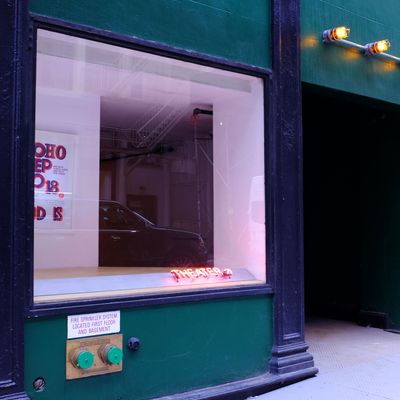
Sarah Benson, one of the co-directors of the Off–Off Broadway theater Soho Rep, remembers just when she hit her panic point this summer. In one week, seven artists she knew announced they were abandoning theater and New York. “They were leaving the field because they couldn’t afford it,” Benson says. “Artists and colleagues and friends literally couldn’t afford to be here.” As an institution, Soho Rep had managed to secure some grant income, allowing the small theater to maintain all its staff positions while hunkering down and weathering the storm. But with artists leaving the city en masse, Benson and the theater’s other directors, Cynthia Flowers and Meropi Peponides, realized that the same storm was washing their community away. Why save money if there was no one to save for? So instead of “shrinking and containing,” says Flowers, they and the board agreed to use their annual budget to take a risk and hire eight artists. Instead of spreading around stipends or small grants, they offered a cohort of directors, actors, designers, and playwrights a job: a true living wage ($1,250 a week) and health insurance, guaranteed from now till next June. Soho Rep Project Number One launched Monday with the first round of checks.
A number of New York’s tiniest theater institutions have been meeting the coronavirus crisis by reassessing their mission, turning themselves from presenting companies into think tanks or micro-granters. The Playwrights Realm, beloved for producing Sarah DeLappe’s The Wolves, will spend the next year as a playwright-services organization, providing stipends even as actual production possibilities vanish, while Ars Nova has been awarding “flash grants” of $2,500 apiece to its wide array of affiliated artists. Small theaters that have brick-and-mortar venues have often turned into mutual-aid centers, opening their lobbies to protesters or the unhoused: The Brick in Williamsburg has been handing out water and masks, and JACK in Clinton Hill temporarily ceded its physical plant to the We Keep Us Safe Abolitionist Network, which uses the space as a food distribution center. Before the pandemic, the avant-garde theater Performance Space New York had already turned its curatorial planning over to a coterie of creators; PSNY’s current fundraising effort “Deeds for AIRs” exists to help five affiliated Black and trans artists “collectively purchase a home outside of NYC.” For all the grieving we’ve done over the end of live performance, something has been happening all this time. Squint and you’ll see it: We’re surrounded by redistribution as art.
The Soho Rep directors, however, feel their job program is more a continuation than a pivot. They’ve announced their ongoing commitments to the shows put on hold by the virus — they are continuing the Writer/Director Lab, though it’s virtual for now, and they’re still first and foremost a theater, with five productions still on the docket for after the pandemic, plus various commissions stretching years into the future. And the new jobs do have duties attached: The eight artists will each need to captain some sort of public-facing project (a book, an outdoor show, anything) and commit to meetings every two weeks, brainstorming conversations about the future of institutional relationships. The cohort (Becca Blackwell, Shayok Misha Chowdhury, Stacey Derosier, David Mendizábal, Ife Olujobi, David Ryan Smith, Carmelita Tropicana, and Jillian Walker) is intergenerational, diverse, and demonstratively interested in thinking about the future of theater. Says Peponides, “We wanted to have all of those folks in the room together, people who we thought would be interested in the bigger-picture conversation. What do we hope for in return? How can Soho Rep in particular and also the field as a whole be a more equitable, inclusive place coming out of this?”
Looked at in a certain light, Soho Rep Project Number One is a nice lifeline for a few people. When the directors were looking for possible participants, making a list of the artists and craftspeople the theater had employed over the previous five seasons, they came up with between 250 and 300 names. Out of that group, they could afford to support only eight. So at the moment, employment is still just another form of lottery, a golden ticket that goes out to the lucky handful. If it catches on as a policy, though, it could be a radical intervention in a broken system.
Outside theater, the idea of hiring some folks with salaries and dental plans may not seem like a big deal. But if staffing for artists were to become common practice, the theater as we know it would be upended completely. Live performance at all levels depends on artists who freelance, cobbling together gigs for survival, and people are typically valued way below product: Soho Rep itself, a progressive organization deeply interested in design and paying above union minimums, has spent years simply paying its designers a flat fee of $3,750 (plus various materials and extension monies), whereas the set itself may cost around $25,000 to construct. Peponides points out that even before the pandemic, it was an “untenable system, in which people’s thought leadership was not compensated or valued at all. What was compensated was ‘I give you this fee, you give me a design’ or ‘I give you this fee, you direct this show.’ And the hundreds of hours of research, of thinking, of conceptualization — all the intangibles that feed into that — were completely uncompensated. So this is also an attempt to intervene and say artists have an inherent value in thought partnership with us, independent of the products they create.”
Will this one theater’s choices influence the field? The much-used freelance-dependent model shifts all the precarity onto individual workers, but it also enables the staggering quantity of performance we’re used to. Changing to an employment model would mean seismic shifts: Theaters would produce less; artists might no longer criss-cross the country looking for jobs. Undoubtedly, radical change is what the directors are wishing for. Says Flowers, “We’re hoping for a complete transformation. There is no going back.” All three of them are hoping the project will reform the theater and its civic function in relation to artists, to bind the cohort into a community and to foreground the part of theater-making that’s usually invisible to audiences — the collaboration and thinking itself. While other theaters have been planning digital programming or online festivals, “we intentionally didn’t jump into that space at all,” says Benson. “If aesthetics is about, like, ‘what is beautiful,’ I think we’re working to recognize the joy and the collaboration and the beauty that’s already embedded in our community. That’s the exercise, you know, the experiment. Can we actually make that visible? Can we make vivid what’s already there?”
More From This Series
- How Do You Measure a Career? The Jonathan Larson Project.
- A Ghosts That Doesn’t Go Mad
- Launching Into Adulthood, With Frenemies and Hummus: All Nighter


